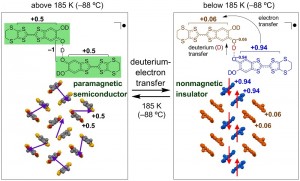Purely organic material can switch electrical conductivity and magnetism Deuterium transfer key to switching properties

Hydrogen bonds form in water and ice, in DNA and proteins, fulfilling roles essential for life and for our lifestyles. Using hydrogen bonds to link atoms and ions within materials, it is possible to control its dielectric properties or ionic conductivity, or cause these properties to switch at a certain temperature. The control and switching of such physical properties and functions in materials utilizing hydrogen bonding is of great interest not just as basic science but also from the standpoint of applied science and practical applications. However, successful examples of such switching based on hydrogen bonding are limited to a small subset of physical properties such as dielectric properties.

© 2014 Akira Ueda.
A purely organic material, κ-D3(Cat-EDT-TTF)2 , is composed of a unit structure where Cat-EDT-TTF molecules (green colored, left) are connected by an (O???D???O) hydrogen bond. At 185K (?88℃), deuterium and electron transfer occurs, changing the electric charge on the two Cat-EDT-TTF molecules, which results in the switching of electrical conductivity (semiconductor ? insulator) and magnetism (paramagnetic ? nonmagnetic).
Assistant Professor Akira Ueda, Professor Hatsumi Mori (Institute for Solid State Physics, the University of Tokyo) and their coworkers have, for the first time, succeeded in the development of a purely organic material that can simultaneously switch its electrical conductivity and magnetism, by utilizing hydrogen-bond dynamics. They have demonstrated that this event is a truly new switching phenomenon, based on the cooperation of thermal deuterium transfer and electron transfer through the hydrogen bond, for which the introduction of deuterium atoms instead of hydrogen plays the key role, in collaboration with Professors Youichi Murakami, Reiji Kumai, and Hironori Nakao (CMRC and Photon Factory, Institute of Materials Structure Science, KEK), Associate Professor Akiko Nakao (Comprehensive Research Organization for Science and Society (CROSS)), Associate Professor Kaoru Yamamoto (Department of Applied Physics, Okayama University of Science), and Professor Yutaka Nishio (Department of Physics, Toho University).
This kind of hydrogen-bond based switching of solid-state electronic properties is a very rare phenomenon. The present result will attract much attention not only as basic science but also from the standpoint of applied science, and is a step towards the development of new types of purely organic thin-film semiconducting/magnetic materials and devices with switching functionality.
The details of this research were published in the Journal of the American Chemical Society (JACS) on 27 August 2014 and highlighted in the JACS Spotlights.
Press release [PDF] (Japanese)
Paper
A. Ueda, S. Yamada, T. Isono, H. Kamo, A. Nakao, R. Kumai, H. Nakao, Y. Murakami, K. Yamamoto, Y. Nishio, and H. Mori,
“Hydrogen-Bond-Dynamics-Based Switching of Conductivity and Magnetism: A Phase Transition Caused by Deuterium and Electron Transfer in a Hydrogen-Bonded Purely Organic Conductor Crystal”,
Journal of the American Chemical Society 136, 2014: 12184-12192, doi: 10.1021/ja507132m.
Article link
Links
Institute for Solid State Physics
Graduate School of Frontier Sciences
Department of Advanced Materials Science, Graduate School of Frontier Sciences
Department of Chemistry, Graduate School of Science
Mori Laboratory, Division of New Materials Science, The Institute for Solid State Physics (Japanese)
Institute of Materials Structure Science, High Energy Accelerator Research Organization (KEK)







